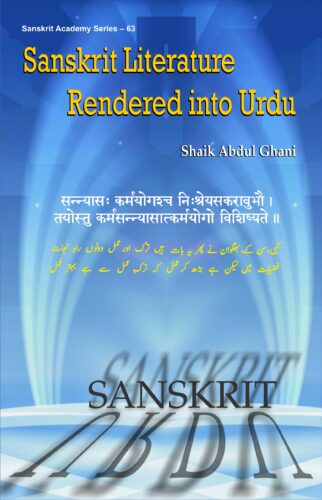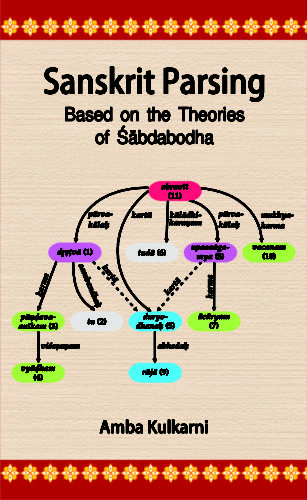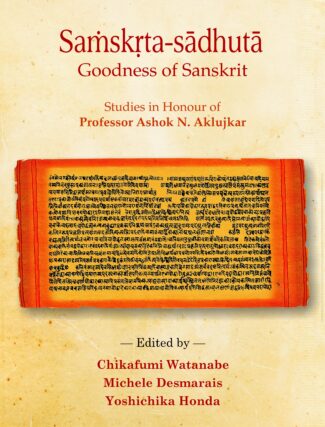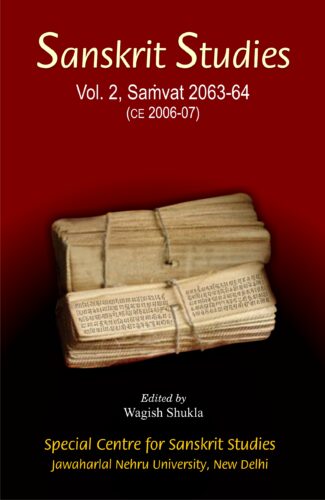Showing 801–810 of 1090 results

In the past many Sanskrit works were translated into Persian and other Indian languages so as to reveal the glory of the Sanskrit language and its literary output. This book presents details of the Urdu translations covering the Vedic literature the Puranas and classical works on various subjects.
Sanskrit literature is a vast tradition, its literary activity being one of the oldest in the world. In the past, many Sanskrit works were translated into Persian and other Indian languages so as to reveal the glory of the Sanskrit language and literary output to all. This book is an attempt to present Urdu translations of Sanskrit literature. The translations include the Gayatri mantra and a few random lines/verses from the Arthashastra, the epic literature especially the Bhagavad Gita, Kalidasas plays, Bahrtrharis Shatakas, the Yoga Darshana of Patanjali and the Kapila Sutras on Sankhya philosophy, in a simple manner and with clarity. It includes a detailed list of various works of Sanskrit translations into Urdu covering the Vedic literature, the Puranas, Sanskrit classical literature like the epics, drama, lyrics, poetry, prose, romance, popular tales and scientific literature on grammar, phonetics, medicine, the law, astronomy and mathematics.

This book presents the key concepts from the Indian Grammatical Tradition (IGT) that are necessary for understanding the information flow in a language string and its dynamics. This is followed by a concrete application of building a parser for Sanskrit using the framework of Indian Grammatical Tradition.
India has a rich grammatical tradition, still extant in the form of Panini’s grammar as well as the theories of verbal cognition. These two together provide a formal theory of language communication. The formal nature of the theory makes it directly relevant to the new technology called Natural Language Processing.
This book, first presents the key concepts from the Indian Grammatical Tradition (IGT) that are necessary for understanding the information flow in a language string and its dynamics. A fresh look at these concepts from the perspective of Natural Language Processing is provided. This is then followed by a concrete application of building a parser for Sanskrit using the framework of Indian Grammatical Tradition.
This book not only documents the salient pieces of work carried out over the last quarter century under Computational Paninian Grammar, but provides the first comprehensive exposition of the ideas involved. It fills a gap for students of Computational Linguistics/Natural Language Processing who are working on Indian languages using Paninian Grammatical Framework for developing their computational models and do not have direct access to the texts in Sanskrit.
Similarly for the Sanskrit scholars and the students it provides an example of concrete application of the Indian theories to solve a contemporary problem.

This book, felicitating Professor Ashok Aklujkar, throws light on the major areas of Sanskrit and related subjects, such as philosophy, religion, linguistics, poetics, art and sociology. It primarily contains essays exploring the complexities of Sanskrit grammars, Indic linguistic philosophy and the relation between Sanskrit and Pali.
Making any valuable and original contribution to the treasure troves of knowledge and world literature based on serious studies, deep thought, extensive research, intensive literary discourses and experience gained through continued exposure and involvement, is not everybody’s forte. It is for such literary acumen, intrinsic scholastic qualities and other personal attributes that make Dr. Ashok Aklujkar stand out and be regarded as the world-renowned Sanskrit scholar of the modern times in whose honour and appreciation this volume has been compiled and published.
Several leading and gifted scholars from across the world have contributed a wide range of interesting research articles for this special volume that deal with major areas of Sanskrit and related studies such as philosophy, religion, linguistics, poetics, art and sociology. As a befitting tribute to the scholarly interests and attainments, reflected in the published works of Prof. Aklujkar, essays exploring the complexities in Sanskrit grammars and Indic linguistic philosophy take the centre stage in this volume. Good care has also been taken to devote sufficient space to the poetics and the inherent relation between Sanskrit and Pali Þ the two other important areas Prof. Aklujkar has focussed on, from time to time.
In this compendium of assorted and absorbing articles authored by quite senior and well-known scholars of repute, appear alongside an equal number of articles from new generation, young scholars of merit, wherein they have attempted to offer the fruits of their original and critical research work.
The result: a panorama of interesting readings that introduce the reader to the unique diversity and richness of Indology from various vantage points.

This volume ranges over logic, grammar, philosophy, environment, aesthetics, interpretation, science, epic-poetry, India’s cultural presence in Asia, and maintenance of texts, and as such should interest students, researchers and teachers of languages, literature, sciences and philosophy.
The educated Indian mind of today is, by and large, subjugated by the contemporary ethnographic, conflict-oriented, divisive thought and ideologies of the West. This can be corrected only by the thought structure in the Sanskrit intellectual texts. Two learned Supreme Court judges noted in 1993 the people of India have always held in high esteem the cultural heritage of this ancient land. And learning of Sanskrit is undoubtedly necessary for protection of this heritage. And the 1986 education policy said, Efforts will be made to delve into India’s ancient fund of knowledge and to relate it to contemporary reality. This effort will imply the development of facilities for the intensive study of Sanskrit. With this in mind, JNU set up in 2002 the Special Centre for Sanskrit Studies to examine and relate Indian thought systems both to the contemporary Indian reality and the contemporary Western thinking. A research journal/publication is integral to this vision. This volume is the first issue and it promises a continuous commitment to Indian thought, its validity and value. We hope that this effort shall build a team of young scholars with a commitment to exact Indian scholarship. This book ranges over logic, grammar, philosophy, environment, aesthetics, interpretation, science, epic-poetry, India’s cultural presence in Asia, and maintenance of texts, and as such should interest students, researchers and teachers of languages, literature, sciences and philosophy. We would like the readers to enjoy this first volume. We welcome comments, observations, responses and also invite contributions for the next volume in the series.

This is a second volume brought out by the Special Centre for Sanskrit Studies, JNU. It’s a collection of scholarly writings that throws light on ancient cultural heritage of India, marked by the Sanskrit intellectual traditions, dealing with schools of Vedas like Niruktas and the Itihasas, and the pre-Harappan Rgveda.
The cultural heritage of India is marked by the Sanskrit intellectual tradition whose flowering resulted in rich literature and development of philosophy, art and the sciences. Sanskrit Studies vol. 2 is the second issue showcasing the rich ancient heritage of Sanskrit brought out by the Centre. This volume is a collection of articles that throws light on various aspects of the Sanskrit tradition. The scholarly writings deal with schools of interpretation of the Vedas like the Niruktas and the Itihasas and evidences and arguments for a pre-Harappan date of composition for the Rigveda. They examine atomistic doctrines in Indian thought tradition, the charms and spells that constitute the Atharvaveda, the place of the Hindu women vis-a-vis ancient Indian society and traditions, and the philosophy and the aesthetics of rasa. Throughout they cite ancient Indian epics and mythologies, religious thoughts, literary works, philosophical traditions and scientific achievements to carry out a thorough and comprehensive study of the subject. There is an interesting article on issues involved in comparative studies of philosophies of two different traditions, as of the East and the West. The volume will appeal to students, teachers and scholars of Indology.

This book, the third volume in the Sanskrit Studies Series of JNU, addresses varied topics of Sanskrit studies such as the Theory of Oral Composition of Veda, Hermeneutics of the Upanisads, Concept of Dharma, Aesthetic Universe of Natyasastra, the Cultural Geography of Kalidasa, Sanskrit Commentary, Archaeoastronomy, Universal Premise in Early Nyaya, among others.
This anthology (2013-14) is the third volume of the Sanskrit Studies, a serial publication from the Special Centre for Sanskrit Studies, Jawaharlal Nehru University (JNU). The first volume of the series was published in 2004-05, and the second in 2006-07. JNU is committed to bring out this serial publication, though with some interval.
This Sanskrit Studies series is set to focus on a vast range of Sanskrit language and literature, grammar and historical linguistics, sources of history and systems of philosophy, principles of poetics and details of dramaturgy, lexicography, and so on. It also aims to bring forth the vision of Vedic texts and the varieties of Vedic traditions, Buddhist canons, Pali texts, different versions of Prakrt language and the emerging field of computational linguistics, thus adopting a multi-disciplinary approach.
This volume too deliberates on varied topics of Sanskrit studies and discusses the theory of Oral Ccomposition of Veda, the Yajusha Hautra Dispute, Hermeneutics of the Upanisads, Concept of Dharma, Aesthetic Universe of Natyasastra, the Cultural Geography of Kalidasa, Sanskrit Commentary, Archaeoastronomy, Universal Premise in Early Nyaya, Sanskrit and Tamil Interrelation, among others.
The fifteen articles presented in this volume represent the richness and rigour of Sanskrit studies in contemporary times across the globe. It should interest all those who are in Sanskrit studies researchers, teachers, students and scholars alike.

This fourth volume in Sanskrit Studies from JNU encompasses a vast range of Sanskrit disciplines including language, literature, grammar and philosophy of Sanskrit, and related disciplines like Pali, Prakrit and Apabhramsha studies, both traditional and modern subjects, showcasing the profound views of erudite scholars from India and abroad.
The fourth volume of Sanskrit studies (2015) is a consecutive publication of the Special Centre for Sanskrit Studies, Jawaharlal Nehru University. This publication from JNU is intended to throw the light on vast range of Sanskrit studies such as language and literature of Sanskrit, Grammar and linguistics, Vedanta and other ancient Indian Philosophies, Poetics, Dramaturgy, Historiography of Vedic Age, Purana and Dharmashastra, etc.
This anthology presents the profound views of experienced and young scholars from India and abroad. It addresses both traditional and modern systems prevailed in the area of Sanskrit Studies. Sanskrit is the source of great inspiration and treasure house of various knowledge systems. Its literature has spread the universal brotherhood and sustainable human relations in the world. Therefore Special Centre for Sanskrit Studies determined to bring out this publication in the field of Sanskrit Studies on vast range of Sanskrit disciplines which cover not only Language, Literature, Grammar and Philosophy of Sanskrit, but also the related disciplines such as Pali, Prakrit and Apabhramsha studies.
The seventeen articles in this volume fourteen in English and three in Sanskrit cover topics such as Champa in the Global Vision of Classical India; Kashmirs Contribution to Sanskrit Literature; Concept of Nirvikalpaka and Savikalpaka; Reconstructing Abhiramamani; Legend of King Nimi and Uttarakanda of Valmiki Ramayana; A Dense Definition of Rupaka; Abduction and Marriage in Ithihasa and Purana; Problem of Iron in Rigvedic Society; Ancient Indian Methodology of Authoring Textbooks; Bana: A Histographer; Vedantadarshne Brahmasvarupam; among others.
Sapiens and Sthitaprajna studies the concept of a wise person in the Stoic Seneca and in the Bhagavadgita. Although the Gita and Seneca’s writings were composed at least two centuries apart and a continent apart, they have much in common in recommending a well-lived life. This book describes how in both a wise person is endowed with both virtue and wisdom, is moral, makes right judgements and takes responsibility for actions. A wise and virtuous person always enjoys happiness, as happiness consists in knowing that one has done the right thing at the right time.
Both Seneca and the Gita demand intellectual rigour and wisdom for leading a virtuous and effective life. They provide guidelines for how to become and be wise. Both systems demand a sage to be emotionally sound and devoid of passions. This leads to mental peace and balance, and ultimately tranquillity and happiness. While surveying these similarities, this study also finds differences in their ways of application of these ideas. The metaphysics of the Gita obliges the sage to practise meditation, while the Stoics require a sage to be a rational person committed to analysing and intellectualizing any situation.
This comparative study will be of interest to students of both Ancient Western and Ancient Indian Philosophy. Practitioners of Stoicism and followers of the Gita should find the presence of closely-related ideas in a very different tradition of interest while perhaps finding somewhat different prescriptions a spur to action.

The book employs the multi-disciplinary methodologies of art historical interpretation to contextualise nearly the whole range of Saptamatrka icons within the larger historical evolution of accultured Brahmanical religion, mythology, theology and cultic developments.
The worship of Saptamatrika; the seven Mother Goddesses (or the seven Saktis, the divine feminine powers), is over a millennia and half old, pan-Indian phenomenon. And, over the centuries, the Matrika concept has come to have varied ideational, literary, visual and ritualistic manifestations which not just interconnect the totality of Brahmanical and non-Brahmanical religious traditions, but are integral components of the diverse historical processes of Indian society. A reputed scholar of art history here offers an insightful iconological study of Saptamatrika divinities: the Brahmanical goddesses found invariably as a single collective whole, consisting literally of seven (though sometimes eight or more) female deities, variably accompanied by different forms of Shiva, and Ganesha or Skanda. Employing the multidisciplinary methodo-logies of art historical interpretation, including the recent feminist interventions, Dr. Panikkars inquiry contextualises nearly the whole range of Saptamatrika icons within the larger historical evolution of accultured Brahmanical religion, mythology, theology and concomitant multifarious cultic developments. Also clarifying some of the basic principles of Brahmanical iconic tradition, his study has, for the first time, exceeded the accepted Art Historical procedures by incorporating the questions of class conflict, gender representations and ideology within the iconological discourse and has, thus, advanced the frontiers of Art Historical practice. It is a compelling, painstakingly researched work growing from the authors indepth survey of diverse Saptamatrika sculptures and an astonishing mass of both primary textual sources and research publications of more recent years. And, yet more significantly, it is enlivened with exquisite visual material: comprising nearly 200 photographic reproductions.

Sarada script has a pride of place among the Indian scripts. Though an alphabet of Kashmir par exellence, it remained for several centuries a popular script of north-western India and an extensive area around it. This book deals with the development of this script and its descendants, the Devasesaa and Takari scripts.
Among the Indian scripts the Sharada script has a pride of place. Though an alphabet of Kashmir par excellence it remained for several centuries a popular script of an extensive area of north-western India including Afghanistan, Gandhara or north-western Pakistan, the Darad territories of Gilgit, Chilas and Chitral, Ladakh, Jammu, Himachal Pradesh and Delhi. The epigraphic and literary records written in the Sharada script that have surfaced in these regions have thrown welcome light on many facets of the history and culture of the area of their provenance. Nearly the entire extant manuscripts of Sanskrit works including those on science, mathematics and erotics besides some old Kashmiri texts are written in this script. The Sharada alphabet was replaced in the 13th century by its descendant, the Devashesha, which in turn gave rise to the modern alphabet of Takari. The epigraphic, literary and other valuable documents of Himachal Pradesh available are mostly written in Devashesha and Takari. But it is sad that the number of scholars having a sound knowledge of the Sharada and Takari scripts is extremely small. There is every apprehension of the complete loss of these two scripts unless serious measures are taken to disseminate the knowledge under the guidance of the epigraphy stalwart to our younger generation of scholars. The entire study of the present work is based on original records and is comprehensively illustrated by palaeographic tables and charts prepared from published facsimilies, photographs, and original inscriptions and manuscripts. To give an idea of the records written in these two scripts, printed photographs of the inscriptions, manuscripts, documents, etc. have been given at the end of the book. It is hoped that the book would serve as a guide and an aid for the scholars interested in the study of the important and valuable records written in Sharada and Takari scripts which are otherwise preserved in museums and libraries in India and abroad.
| There are no products |